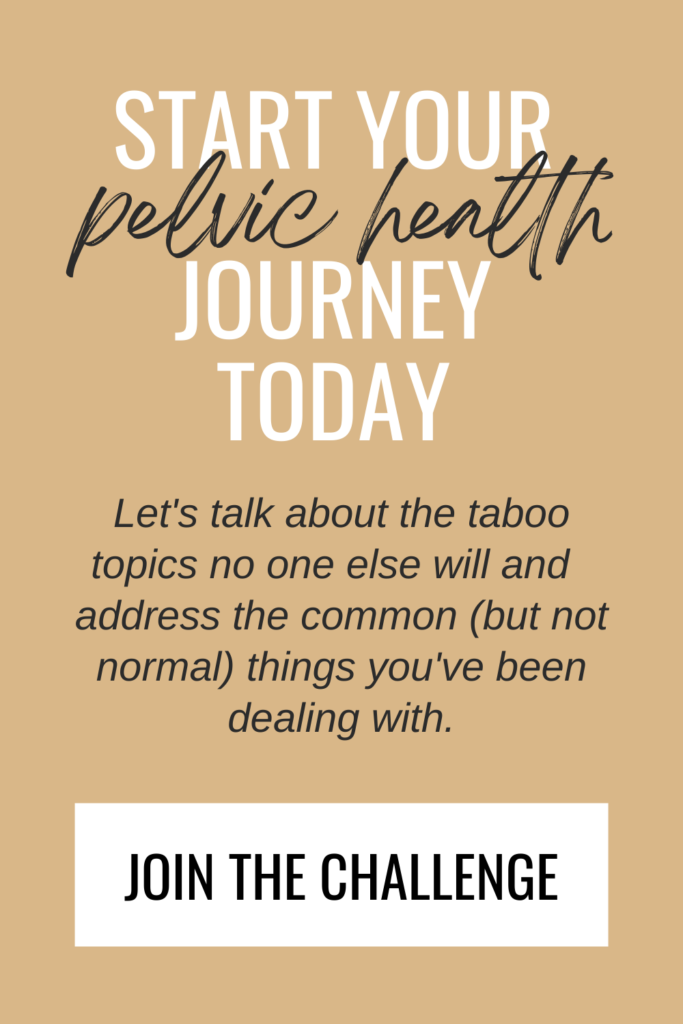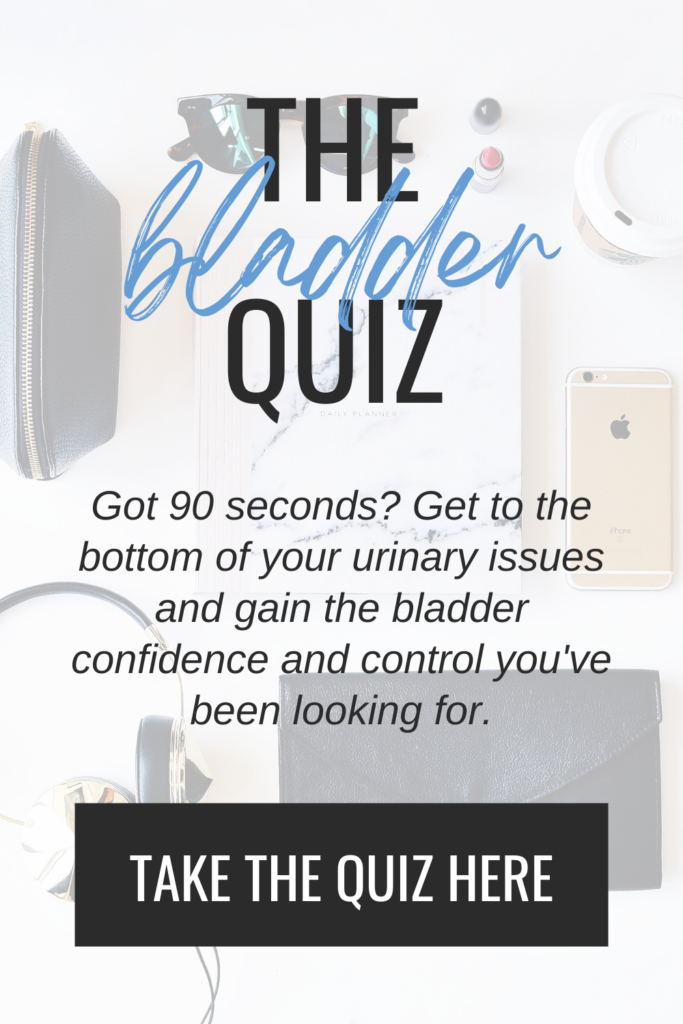Hi…it’s me…your favorite soapbox standin’, mic droppin’, willing to die on all the hills pelvic rehab therapist comin’ in hot with a fewwwww pelvic health facts I think EV-ERY-ONE should know. While these unpopular opinions are backed by clinical experience, my personal health journey, and, of course, scientific research (how we ~always~ roll around here), I’ll likely get a little pushback for some of the things I’m sharing today.
Medical information is so accessible nowadays (#praise), and as my mom once so lovingly reminded me, “everything I know is on Google”…thanks, mom. But there’s also such a thing as medical misinformation, and some of the rumors out there around pelvic health are leading to unnecessary confusion, frustration, and ongoing pelvic health problems, and it’s about dang time someone sets the record straight.
RELATED POST: How to Be Bold In Your Health: A Guide to Getting the Medical Care You Deserve
I can’t fault women (or even other medical professionals, for that matter) for not fully understanding the pelvic floor – it’s a complex structure of muscles, bones, and nerves that involves the bladder, bowel, and reproductive systems. But people like me who specialize in this area of the body will literally ~jump~ at the opportunity to bust a few myths and put some personal pet peeves to sleep…and you better believe I’m takin’ my chance!
I’m warning ya – some of these pelvic health facts miiiiiiight challenge or contradict what you’ve been told by your doctor, seen on social media, taught by your mom, or heard from your bestie…hence why I’m calling them “unpopular opinions”. It’s my mission to make this information common knowledge, and reaching that goal continues right here, right now, you and I. Let’s go!
You don’t want a tight pelvic floor…trust me.
For years…decades…maybe even centuries, women have been boasting the benefits of a “tight vagina”. But if any other muscle in the body is tight, it would be a problem (right!?), and the pelvic floor is no different. While many assume pelvic floor tightness equates to strength and greater sexual pleasure, it’s ~actually~ the primary cause of pelvic pain, weakness, and dysfunction (aka pain with sex, alllll the bladder probs, constipation, painful periods, and pelvic organ prolapse…to name a few).
Believe it or not, the average woman has a tight pelvic floor and would benefit from learning how to relax these muscles instead (which you can conveniently do right here inside this FREE guide), especially if she has any pelvic health concerns. Relieving muscle tension improves its health, strength, function, and coordination, and resolves so many pelvic floor issues in the process.
RELATED POST: 18 Reasons You Have a Tight Pelvic Floor (Plus…What to Do About It)
RELATED POST: My Daily Pelvic Floor Relaxation Routine & Why You Might Want to Try It Too
Kegels (unfortunately) won’t solve everything.
Because we’ve already established a tight pelvic floor iiiiiisn’t quite a good thing, it shouldn’t shock you that kegels aren’t always appropriate or all they’re cracked up to be. Sure, there’s a time and place for them (and this FREE GUIDE will help you perform kegels safely & effectively), but the average woman doesn’t need to be wasting her time, energy, or money on the apps, kegel balls, vibrating undies, or shock wave chair…m’kay??
RELATED POST: A Pelvic Rehab Therapist’s Guide to Popular Pelvic Floor Strengthening Tools
If you have a hard time doing kegels, can’t remember to do them to save your life, tried them in the past with little to no results, ooooooor even feel like they made your symptoms worse…you can let out a sigh of relief because you’re not alone. In fact, these very points are why kegels sit at the bottom of my patient’s to-do lists. There’s so much more to a healthy pelvic floor than muscles that can contract on command, so I’m giving you permission to slow your roll on doing hundreds of kegels a day, and even drop the guilt if you’re not doing any at all.
RELATED POST: 5 Reason Kegels Aren’t Working for You
RELATED POST: Strengthen Your Pelvic Floor With Zero (Yes…Zero) Kegels a Day – Here’s How!
Sex ~really~ shouldn’t be painful.
Can I just put a period at the end of this one and call it good??? Sex should be pleasurable, intimate, and dare I say it…fun, and if pelvic pain is putting a hitch in that giddy-up, then something’s not quite right and there’s liiiiiikely steps you can take to address this (despite how long it’s been going on or what your doctor says). Just because painful sex is common (because…ahem…pelvic floor tightness is common) doesn’t mean you have to tolerate it. You deserve enjoyable sex, and sometimes just knowing there are answers and alternatives is the first step.
RELATED POST: [Everything] You Need to Know About Vaginal Dilators
Psst…small bladders don’t exist.
There is physically…anatomically…literally no such thing as a “small bladder”, yet this is the typical explanation people give for frequent bathroom breaks and the strong urge to pee. I personally find this pelvic health fact to be a positive and ultimately a breath of fresh air, because it means you’re not stuck with a bladder too tiny to do its job. Those “small bladder” symptoms are simply a sign of pelvic floor dysfunction, and rather than cursing your bladder or attempting to trade it in for a new one, oftentimes all you need are the habits and strategies to improve you bladder control and capacity.
RELATED POST: Urinary Urgency & Frequency? You’ve Gotta Stop Making These 5 [Big] Bladder Mistakes
PS- If you’re ready for a better bladder that can keep up with your beautiful, busy, bold & ambitious life, my 8-week online course, The Bladder Blueprint, is your fastest, easiest, most effective answer to kissing those “small bladder” probs goodbye.
Pubic hair is a positive!
I’m a firm believer we have each and every body part for a reason (I’m lookin’ at you, appendix!), and pubic hair is no exception. While I too was known to bare it all to my waxing gal, I now know the benefits of pubic hair – protects dirt and bacteria, wicks & absorbs moisture, reduces skin friction & irritation, and increases clitoral stimulation – and preach its positives, especially to those deal with any of the above.
RELATED POST: The 411 On Pubic Hair & Your Ultimate Guide to Care for “Down There”
To keep or to cut has become a difficult decision now that options like waxing, sugaring, shaving, laser, and electrolysis have come on the scene. And while the benefits of pubic hair are obvious, there are outside factors and internal inclinations that will shape your final choice. While I have my own personal & professional preferences when it comes to pubic hair, I ultimately support whichever route you choose. As long as you make that decision in an informed manor, I’m here for it!
Please don’t use soap down there.
While we’re on the subject of the vulva, let me drop the pelvic health fact that gets the widest eyes aaaaand biggest push-back in my clinic. Cleaning the vulva with soap (yes…even the all-natural, toxin-free, gentle-as-can-be feminine washes) can interrupt the body’s ability to self-clean, and could also be the culprit for the ingrown hairs, folliculitis, odor, and irritation you use said soap for in the first place.
Because the vagina is a self-cleaning structure that uses discharge and mucus to decrease dirt and bacteria, water and your hand are all you need to safely and effectively wash your vulva (trust me on this!). Just fill you hand with water and splash it on and around the vulva while in the shower, or if you take baths, swish water around the area BEFORE adding any soaps or shampoos to the mix. And if you’re fancy fancy, use your removable shower head on the lowest setting and simply spray away.
Nighttime peeing isn’t normal.
Sleep is one of the most underrated and easily accessible wellness tools, so naturally I’m obsessed with finding every possible way to get the most out of this amazing and…um…necessary health hack. Unfortunately, many women find their deep and REM sleep cycles interrupted by the need to pee, which completely eliminates any potential restfulness or health benefits.
RELATED POST: Your Day Starts at Bedtime: 25 Easy Habits for a Better Night’s Sleep
Unless you’re over the age of 60, waking at night to urinate is not normal or necessary. The bladder can and should hold your urine through the evening (remember – there’s no such thing as a “small bladder”), therefore nighttime urinating can be a sign of poor bladder habits, bladder irritation, tight pelvic floor muscles, poor circulation, or sleep apnea and should be addressed.
You proooobably don’t need to drink a gallon of water.
The “gallon challenge”, 75 Hard, and good ol’ Tiktok have made drinking a gallon of water seem like a trend worth adopting. But there *is* such a thing as too much water for body and bladder health, and like all other wellness tips, personalization and individualism are key. So what’s the right amount of water for you? Here’s the water-drinking rules I recommend following –
- Drink half of your body weight (in pounds) in ounces of water. For example, if someone weighs 150 pounds, they should be drinking about 75 ounces of water per day.
- Consume more like two thirds of your body weight (in pounds) in ounces of water if you’re pregnant, breastfeeding, living at higher altitudes, in warmer climates, or exercise vigorously regularly.
- If you do the math and find you’re drinking too much or too little, don’t jump to your water drinking goal amount tomorrow. Sudden changes in water consumption can actually “shock” the body and especially affect the bladder. Instead, slowly adjust how much you’re drinking by about 10 ounces a week until you get to your target amount.
- Drink steadily and regularly throughout the day, limiting the need to take in large amounts at any one time; anywhere from 5-10 ounces of water per hour usually adds up to the right amount for most.
“Common” and “normal” are two *very* different words.
I do my best to not interrupt my patients, but when they misuse or confuse the words “common” and “normal”, you better believe I (kindly) cut them off and (happily) correct them reallllllll quick. Bladder, bowel, and sexual dysfunction are very common – especially for women and specifically for women who have had babies, are in menopause, have lived through trauma or abuse, or have a childhood history of pelvic health issues – but just because something happens often doesn’t mean it’s normal.
The fact that things like urinary leakage, pain with sex, and agonizing periods have been normalized is why more research isn’t being done on these subjects and women aren’t getting the care they deserve. The sooner we stop making excuses for these issues or shrugging them off, the faster women will be heard, treated appropriately, and see resolution of their symptoms
EV-ER-Y woman would benefit from a pelvic health consultation.
Obviously I’m a fan of pelvic floor physical therapy…I am one, I’ve personally benefitted from the care of one, and I get to witness lives changed by it on the daily. Because every woman has a pelvic floor and physical therapy can be successful both reactively and proactively for bladder, bowel, and reproductive health issues, I stand firm in the belief that every woman would benefit from working with and learning from a pelvic floor PT.
RELATED POST: Why A Pelvic Floor Check-Up Should Be on This Year’s To-Do List
If you like my intuitive, actionable and sustainable approach to women’s health (or there’s not a specialist in your area, you don’t have time to make in-clinic appointments, you prefer not to sit on a waitlist forever, or you simply have an aversion to awful fluorescent lights), I have virtual pelvic health consults available and would L-O-V-E to help you find success on your pelvic health journey. Click here to schedule an appointment with me today!
Action trumps knowledge…every time.
As your fellow bluelight glasses wearin’, blog readin’, and podcast listenin’ gal pal, I love learning just as much as you. But I’ve found all the knowledge in the world doesn’t lead to results unless I take action. And maybe you’ve found the same. I get endless joy from sharing pelvic health facts and information, but what really lights me up is hearing about the proactivity that results in success stories and testimonials of tips that were so good you had to tell your bestie. So all those links you see scattered throughout this post? Each is an opportunity to take the next step, and you’ve got my support 1000000000% of the way.
RELATED POST: 4 Key Signs You’re Ready to Fix Your Bladder Issues
RELATED POST: 5 Unexpected Benefits of Making My Pelvic Health a Priority
Well, whadaya think? These are the pelvic health facts that leave my patients asking “why has no one told me about this?!”, and tbh…I felt the same way when I learned these things too. A simple mindset shift or ah-ha moment can be all it takes to make that first step in your wellness journey and all the difference in your pelvic health. So when I get the opportunity to share these unpopular opinions, you better believe I jump on it!
If more than one of these ideas are new to you and you’re excited to get started, I recommend not changing everything at once. Confidently check off the ones you’re already doing, pick one or two places you feel you can have the biggest impact, make it a habit, then move on to the next.
Now I’d like to ask ya for a favor – if you have someone in your life who could use this info in front of their eyeballs, will you forward this their way? As I said in the beginning, I want these facts to become common knowledge to the “average” woman, and we can accomplish that one social media share, text message, or email at a time, and I love ya for being a part of that movement with me.
*steps off soapbox*
– Amanda
Disclaimer: The content provided here does not constitute medical advice, nor is it a substitute for personalized healthcare. I’m a doctor, but I’m not your doctor. If you have concerns about a medical condition, diagnosis, or treatment, you should consult with a licensed healthcare professional.



















